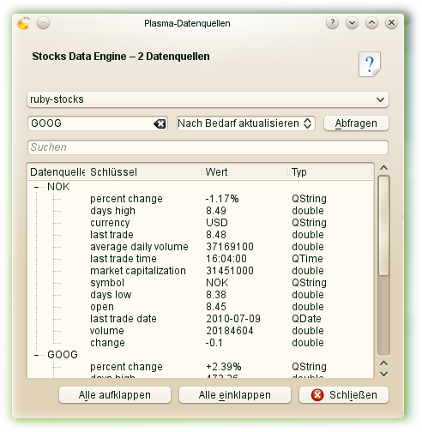Making Of ruby-stocks Plasma DataEngine
Hello Planet KDE, hello RubyCorner
Since I wrote my last Blog post much time has past. After my last exam last Friday I just started to do some hacking on KDE. As it should be something simple for the beginning and something useful, too, I decided to provide a new plasma dataengine for retrieving stocks information.
I used ruby, because plasma hacking with ruby is freaking awesome and totally easy. Let’s prove it!
How To Use It
 Before diving into the
development process, you probably want to test the final result yourself.
First you have to download the plasma package. Then you can install
it easily with the plasma package manager.
Before diving into the
development process, you probably want to test the final result yourself.
First you have to download the plasma package. Then you can install
it easily with the plasma package manager.
plasmapkg -t dataengine -i plasma-dataengine-ruby-stocks-v1.0.zip
You won’t need to be root for that. You should get a success response afterwards.
As there is by now no plasmoid to display the provided data, you have to use
the plasmaengineexplorer to test the engine. Call this program on your shell
and look for ruby-stocks. You have to type in a stocks symbol like GOOG (Google)
or NOK (Nokia) to get the information. Is is also possible to just call:
plasmaengineexplorer --engine ruby-stocks --source NOK
You can remove the engine with this short command:
plasmapkg -t dataengine -r ruby-stocks
How To Create It
I started with a look on the plasma ruby examples and copied the inital construct from the given time data engine example. There was also an attempt to create a stocks engine with C++. The code is available in the playground.
The most time took the clean implementation of the cvs data parsing.
If you want to start yourself with a ruby based dataengine, I recommend to start with the time engine example, too. Do not change the given file structure, which should be:
plasma-dataengine-ruby-stocks ├── contents │ └── code │ ├── main.rb │ └── … └── metadata.desktop
The top directory gets packaged into a zip for distribution.
Let’s take a look on the main.rb. There a some important things you have to be aware of, when you want to use ruby for plasma dataengines:
- when you name your engine “ruby-stocks” (see metadata.desktop), you have to name the top module RubyStocks. Otherwise your engine will fail.
- Plasma looks for a class called Main in that module, which have to inherit from PlasmaScripting::DataEngine
- make sure, that you implement the member methods: sourceRequestEvent and updateSourceEvent
As both methods should do the same in my example, I used an method alias. If you ever did a plasma dataengine using C++ you have noticed, that it is a straight forward port from C++ to ruby. There is hardly something different.
# file: 'main.rb'
# kate: remove-trailing-space on; replace-trailing-space-save on; indent-width 2; indent-mode ruby; syntax ruby; replace-tabs on; replace-tabs-save on; space-indent on;
require 'plasma_applet'
# the dictonary replaces the ruby hash as we need an ordered hash. only ruby 1.9 uses ordered one.
# when ruby1.9 is the default version, we can switch back to native ruby hash
require 'dictionary'
module RubyStocks
class Main < PlasmaScripting::DataEngine
# the url needs to be extended by the stock ID at the end of the string
# format code: http://brusdeylins.info/projects/yahoo-finance-api/
DATA = Dictionary[
"j1" => ["market capitalization", Float],
"p2" => ["percent change", String],
"s0" => ["symbol",String],
"d1" => ["last trade date", Qt::Date],
"t1" => ["last trade time", Qt::Time],
"c1" => ["change", Float],
"o0" => ["open", Float],
"h0" => ["days high", Float],
"g0" => ["days low", Float],
"v0" => ["volume", Float],
"a2" => ["average daily volume", Float],
"l1" => ["last trade", Float],
"c4" => ["currency", String]
]
SOURCE_URL = "http://download.finance.yahoo.com/d/quotes.csv?f=#{DATA.keys.join}&e=.csv&s="
def initialize parent, args = nil
super parent
# don't update faster than once a minute
setMinimumPollingInterval 60000
# dafault update rate is 10 minutes
setPollingInterval 600000
end
def updateSourceEvent source
request_url = SOURCE_URL + Qt::Url::toPercentEncoding(source).data.strip
job = KIO::storedGet KDE::Url.new(request_url), KIO::NoReload, KIO::HideProgressInfo
job.connect( SIGNAL( 'result( KJob* )' ) ) do |aJob|
parseCSVLine source, aJob.data
end
return false
end
def parseCSVLine source, dataByteArray
$stderr.puts "ruby-stocks plasma dataengine: retrieved data: " + dataByteArray.data
dataArray = dataByteArray.data.strip.split ","
if dataArray.size >= DATA.size
DATA.values.each do |aValue|
data = dataArray.shift
unless data =~ %r{N/A}
if aValue[1] == Float
data.gsub! /B$/, "E6"
data.gsub! /M$/, "E3"
setData source, aValue[0], data.to_f unless data == "N/A"
elsif aValue[1] == String
data = data[1..-2]
setData source, aValue[0], data unless data.empty?
elsif aValue[1] == Qt::Time
setData source, aValue[0], Qt::Time.fromString(data, '"h:mmap"')
elsif aValue[1] == Qt::Date
setData source, aValue[0], Qt::Date.fromString(data, '"M/d/yyyy"')
end
end
end
end
end
alias sourceRequestEvent updateSourceEvent
end
end
The second file you need is the metadata.desktop.
# file: 'metadata.desktop'
[Desktop Entry]
Name=Stocks Data Engine
Comment=Stocks Data Engine powered by Yahoo! Finance (real time delayed by around 15 minutes
Type=Service
ServiceTypes=Plasma/DataEngine
X-Plasma-API=ruby-script
X-Plasma-MainScript=code/main.rb
X-KDE-PluginInfo-Author=Robert Riemann
X-KDE-PluginInfo-Email=saloution@googlemail.com
X-KDE-PluginInfo-Name=ruby-stocks
X-KDE-PluginInfo-Version=1.0
X-KDE-PluginInfo-Website=http://plasma.kde.org/
X-KDE-PluginInfo-Category=Online Services
X-KDE-PluginInfo-Depends=
X-KDE-PluginInfo-License=GPL
X-KDE-PluginInfo-EnabledByDefault=true
# Icon=alarmclock
What Comes Next?
The engine should be quite usable by now. I plan to create a plasmoid which lets you search for a company name to get the stocks symbol and then shows some important numbers (like the weather widget, but without these nice graphics).
After that I want to create a second plasmoid which just shows a chart from Yahoo! Finance. The most work will probably be to create a settings dialog similar to the one you find here below the chart.
What do you think? Would you use a stocks plasmoid? What do you expect it to display?
Why didn’t you have already used ruby to create a dataengine? ![]() And after all,
how do I get this engine into KDE trunk?
And after all,
how do I get this engine into KDE trunk?